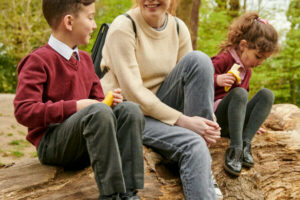What is the winter solstice and why is it important?
For many cultures, the winter solstice was (and still is) a time to celebrate the return of the sun and the lengthening of days. The winter solstice is the shortest day and longest night of the year. Cultures around the world have celebrated holidays, held feasts, and enjoyed the winter solstice in a variety of ways.
We’ve compiled a handy list of some ideas on how to enjoy and celebrate the winter solstice with your children, with activities appropriate for all ages.

What are some winter solstice activities that parents can do with their children?
Caregivers can enjoy many activities with children to celebrate the winter solstice. We’ve divided this list into indoor and outdoor activities.
Indoor Activities
Crafty:

These lanterns look super cool but are simple to make, and are a great winter solstice activity to do exploring light and dark with the chance to unleash some creative energy beautifully. The instructions and some great talking points can be found here.
Learning:
There are 3 major structures and buildings associated with the winter solstice: Stonehenge, Newgrange, and Maeshawe. Take a closer look at these places with the kids and read about their connection to the winter solstice – makes for a great learning experience for you and the kids!
Teamwork:
Build a replica of Stonehenge! Work in teams or in competition to make it a bit more fun using anything you can find, be it cardboard boxes, dominoes, cups, woodblocks, and Lego to come up with your version of the momentous monument.
Historical recreations:
In ancient times, there has been tons of activities related to the winter solstice – ranging from feasts to bonfires to reading poetry. Something that could be done at home could be a ‘feast’ of your own kind, with hot chocolates and nibbles with the chance to watch documentaries or read stories on the winter solstice.
Some good recommendations for stories include:
- The Shortest Day by Susan Cooper
- The Winter Solstice by Ellen Jackson + Jan Davey Ellis
- Goodbye Autumn, Hello Winter by Kenard Pak
- A Solstice Tree for Jenny by Karen Shragg
- The Return of the Light by Caryolyn Edwards
Outdoors Activities

Winter Walk:
Make sure to bundle up and take the kids out for a winter-themed nature walk, perfect to marvel at the changing environment and some of the natural wonders. Some fun ideas for themed walks that we love are:
- Sense of Hearing Walk: what does winter sound like?
- Sense of Touch Walk: what does winter feel like?
- Star Walk: take a nighttime walk and look up at the sky to see what constellations are visible or take a moonlit walk.
Scavenger Hunt:
Explore your senses with a scavenger hunt based on finding ‘wintery’ items. Create space for the kids to bring their treasures back, including stuff like pine cones, twigs, and holly. If you’d rather leave the stuff outdoors, you can take pictures of their discoveries and talk about the,m when home. This activity creates fun discussions and interesting sensory experiences for the kids.
Historical recreations:
In ancient times, the winter solstice was celebrated with lots of light, the burning of yule logs, and bonfires. Nowadays, that may be a little unrealistic, but something fun to do with kids outdoors could be to light tealights in the garden and stargaze or walk around with torches to discover some wintery treasures.
What is outdoor learning?
Outdoor learning is important for children, and winter provides the perfect opportunity to experience different weather and sensory experiences. The muddy puddles, frosty grass, and cold noses are all part of the learning and development processes essential for children.
Some of the ideas we outlined of winter walks and scavenger hunts are perfect for your child’s development and awareness of the natural world. If you collect materials on your scavenger hunt, they can be used for crafty activities later on! Plus, the ideas we outlined don’t need to be limited to the winter solstice, and can be done anytime, any season.
What are some benefits of spending time outdoors?
For children, spending time in nature can provide a sense of calm and connect them to the natural world. Spending time outdoors is important for children’s physical and mental health. Outdoor activities can help reduce stress and improve moods, which are essential for healthy development.
Winter can be a magical time for children, full of wonder and exploration. The sparkly Christmas lights, beautiful trees, and general air of cheer make for an exciting time for kids. Taking the time to be outside and enjoy the season can be incredibly rewarding for both children and adults alike.

How can I increase the time my child spends outdoors?
Forest Education is a way to formalise this connection to the natural world, as it can help promote physical activity and exploration, as well as encourage creativity and imagination. Forest School, or just making sure your kids spend a few hours at least outdoors every week, is great for developing physical motor skills, self-confidence, and emotional awareness of the natural world. The activities in the forest can also be applied to the national curriculum, whether it’s understanding the properties of shapes, doing science practicals at the fire pit, or learning the meaning of words through woodland stories.
Spending time in nature has been shown to have numerous mental and physical health benefits for both children and adults alike, so the opportunity to explore some of our winter solstice activities may help you decide what activities your kids enjoy outdoors, and boost your mental health at the same time!



